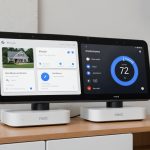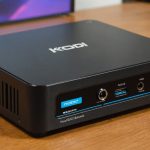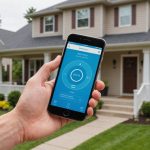Overview of Home Automation with Google Nest Hub
Home automation is revolutionising the way we interact with our living spaces. By integrating various devices into a smart home setup, homeowners can enjoy enhanced convenience, efficiency, and peace of mind.
The Google Nest Hub stands out as a formidable tool in the realm of home automation. Designed to be the central device in your smart home setup, it seamlessly connects different smart devices, allowing for unified control. Imagine being able to dim the lights, adjust the thermostat, or check your front-door camera, all from a single interface. This level of connectivity transforms everyday tasks into delightful experiences.
Also to discover : The definitive handbook for enhancing your intel nuc for flawless 4k streaming with kodi
Core features of the Google Nest Hub augment home automation efforts. The Hub’s ability to control a multitude of smart devices is both practical and empowering, ensuring that every aspect of your living space responds to your needs. Features like voice control and interactive displays make managing your home intuitive and engaging.
As a central player in home automation, the Google Nest Hub enriches the smart living experience, making tasks more convenient and homes more efficient. With its innovative capabilities, it sets the stage for a smarter, more interconnected future.
Additional reading : Mastering multi-bay thunderbolt 3 raid: top strategies for streamlined high-quality video editing
Essential Security Measures for Home Automation
In the realm of smart home security, establishing strong passwords and enabling two-factor authentication cannot be overstated. These measures stand as the first line of defense against unauthorized access. A robust password, comprising a mix of letters, numbers, and special characters, significantly reduces the risk of compromise.
Device protection extends beyond passwords. Regular software updates are crucial, as manufacturers frequently release patches to address vulnerabilities. Ignoring updates can leave your devices exposed to cybersecurity threats.
Beyond device security, safeguarding your home network is paramount. Employing a Virtual Private Network (VPN) provides an additional layer of security, encrypting your data and protecting your privacy. This step is especially important when accessing home automation systems remotely. The network’s security is further enhanced by changing default router settings, using a strong Wi-Fi password, and disabling features like guest networking if unnecessary.
Ensuring data privacy includes understanding how your data is handled by different devices and services. Reviewing privacy policies and settings for each device can offer insights into sharing and storage practices. Being aware of how data flows through your smart home ecosystem can empower you to make informed decisions for effective home automation security.
Choosing Compatible Devices for Google Nest Hub
Selecting smart home devices compatible with the Google Nest Hub is a critical step towards creating a seamless tech ecosystem in your home. Google Nest Hub, powered by Google Assistant, offers compatibility with a wide range of devices, enabling users to control various aspects of their environment with ease.
When considering adding devices, the first key factor is compatibility. Google Assistant compatibility ensures that devices can communicate effectively with the Nest Hub, allowing for integrated control through voice commands or the Nest Hub interface. It’s crucial to check this feature before making any purchase.
Popular smart home brands, like Philips Hue for lighting, Nest for thermostats, and Arlo for security cameras, offer products that are often Google Assistant-friendly. These brands are frequently updated to maintain and enhance compatibility with platforms like Google Nest Hub.
For more options, explore devices from Samsung SmartThings and TP-Link’s Kasa. These brands provide a variety of products such as smart plugs, switches, and sensors that integrate well with Google’s smart ecosystem. By choosing products from these trusted brands, users can enjoy a smooth, integrated experience with their smart home setup.
Step-by-Step Guide to Setting Up Your Home Automation System
Setting up a home automation system can be a seamless experience if approached systematically.
Preparing Your Home Network
The first step in your Home Automation Setup is ensuring your home network is robust. This involves checking your Wi-Fi signal strength and ensuring your internet router is centrally located. A strong network will support a more reliable Google Nest Hub Setup and ensure all connected devices communicate effectively.
Connecting Devices to Google Nest Hub
Next, focus on connecting your devices to the Google Nest Hub. Begin by enabling Bluetooth on the devices you wish to connect. Open the Google Home app and search for nearby devices. Follow the on-screen instructions to add each device to your network, paying close attention to room assignments for effective organization.
Creating Routines for Automation
After connecting your devices, you can start creating routines to automate daily tasks. Use the Configuration Guide found in the Google Home app to set up routines like waking up with gentle lighting or starting your coffee machine in the morning. Each routine can be customized to fit your lifestyle and preferences. Routines become powerful when they are tailored specifically for you, turning mundane tasks into effortless processes.
Optimizing Performance of Your Home Automation System
Enhancing the efficiency of your home automation system is essential for a smooth experience. Start with improving device response times. Ensure a robust internet connection and prioritize the placement of your hub in a central location to optimize communication with all your devices.
Managing energy consumption is equally important. Begin by monitoring your usage patterns to identify inefficiencies. Smart plugs and energy monitoring tools can help track and reduce unnecessary energy drain from devices. This not only saves on electricity bills but also prolongs the life of your smart gadgets.
Another key factor is leveraging routines and schedules. Automating daily tasks can significantly enhance living conditions and device efficiency. For example, setting a routine to turn off lights and appliances when not in use minimizes wastage and simplifies energy management.
Implementing these performance tips not only streamlines operation but also ensures your system runs efficiently. By focusing on these areas, you’ll enhance the reliability and functionality of your home automation setup. With careful planning and management, your smart home gains the dual benefits of convenience and an energy-efficient environment.
Troubleshooting Common Issues with Google Nest Hub
Navigating the occasional hiccup with your Google Nest Hub can be frustrating, yet common issues are often easy to resolve. Let’s take a closer look at some prevalent problems and their solutions.
Connectivity problems are a frequent concern. If your Google Nest Hub struggles to maintain a Wi-Fi connection, ensure it is within range of your router and the signal is strong. Rebooting the device and the router can often rectify connectivity hiccups. Additionally, verifying the Hub’s software is up-to-date can pre-empt potential glitches related to outdated firmware.
Device compatibility is another challenge users face. If your Nest Hub isn’t syncing with other smart devices, check the compatibility list provided by Google. Sometimes, ensure all connected devices are logged into the same network and associated with the same Google account to prevent mismatch errors.
Routine malfunctions and errors may occur, such as unresponsive screens or delayed commands. A simple restart often resolves minor glitches. If the issue persists, performing a factory reset can restore the Hub to its default settings, potentially resolving deeper software conflicts. However, be aware that a factory reset will erase all custom settings and data, so consider this method as a last resort.
Real User Experiences and Case Studies
Exploring user experiences in smart home environments provides valuable insights into practical applications. For instance, Jane from London seamlessly integrated her lighting and heating systems, leading to notable energy savings and increased comfort. This success story illustrates leveraging technology for convenience and cost-effectiveness.
Case studies reveal challenges like compatibility issues in automation setups. However, with strategic upgrades and choosing systems supporting multiple protocols, users can enhance efficiency. A household in Manchester encountered this while connecting older appliances. Their solution involved incorporating a universal hub, ensuring all devices communicated effectively, thus eliminating frustration and operational hiccups.
Here are some tips derived from these smart home success stories:
- Invest in a universal hub if dealing with disparate systems.
- Regularly update your software to avoid security vulnerabilities.
- Choose devices from brands known for their customer support and compatibility.
Emphasising learning from user experiences, experienced users suggest focusing on simplicity. Start with basic automations and expand as comfort grows. This method reduces overwhelm and promotes gradual building of a robust, secure home automation system. Consider consulting community forums and online resources for shared case studies and advice. These insights pave the way for a smooth journey towards an efficient and user-friendly smart home experience, unleashing the true potential of automation.






